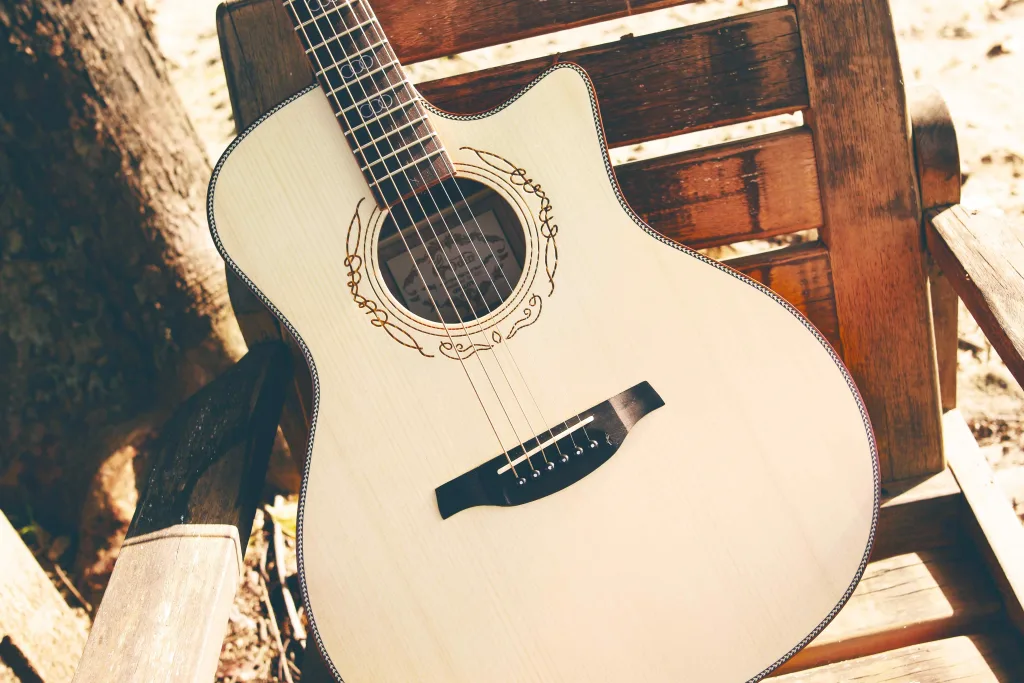Get ready to dive into the world of acoustic guitars!
Imagine standing before two guitar giants: the Dreadnought and the Jumbo.
These two have their own unique sounds and styles, and in this article, we’re going to explore what makes them special.
Whether you’re a seasoned player or just starting out, join us as we unravel the differences between these musical powerhouses. Let’s find out which one could be your perfect strumming partner!
What Is a Dreadnought Guitar?
The Dreadnought guitar is the most common type of acoustic guitar you’ll see. It was first created by Martin Guitars in 1916, and the name “dreadnought” came from a type of battleship used by the British Navy.
Dreadnought guitars have unique traits, such as:
- They have a less curvy middle part compared to other guitar shapes.
- Being able to make a lot of different sounds, especially deep and strong bass tones.
- Their scale length is around 25.5 inches (647mm).
- Their body depth varies from around 3.8 to 4.7 inches (96 to 124mm).
What Is a Jumbo Guitar?
The Jumbo guitar is the biggest among all the usual shapes for acoustic guitars.
In terms of looks, a Jumbo is like a super-sized relative of the grand auditorium shape, and it’s quite different from the dreadnought acoustic guitars.
Back in the 1930s, Gibson wanted to make something even bigger than Martin’s dreadnought, so they came up with the Jumbo.
Here are the traits of the Jumbo guitars:
- More apparent waist, similar to the smaller acoustic guitars shapes
- They produced louder sounds with more sustain
- Their scale length is around 25.5″ (647mm)
- Their body depth is around 4.3″ to 5.1″ (110 – 130mm)

Differences Between Jumbo Guitar and Dreadnought Guitar
Now, let’s explore the main differences between dreadnought and jumbo guitar:
Differences in Body Shape
- Jumbo guitars are bigger, but they have a slimmer waist. This makes them look rounder and nicer to some people. Their curves make them comfy to hold, even though they’re big.
- Dreadnought guitars have a wider waist, and that makes them look like a box to me.
Differences in Sound
- Jumbo Guitars is a bigger version of a Grand Auditorium guitar. They have the perfect mix of low, middle, and high tones. Because it’s bigger, it’s louder, but you need to put in a bit more effort for the sound to really shine.
- Dreadnought Guitars gives more bass, but the middle and high tones still come through nicely. One interesting thing is that the middle part sounds a bit softer because of the wider waist. I think this works great for singers because their voices will stand out in the music mix.
Differences in Tonewood
- Jumbo Guitars often use maple for the back and sides (though there are other choices too). Maple wood gives a bright and sharp sound.
- Dreadnought Guitars can be made from various woods like Spruce, Mahogany, Rosewood, Maple, and others. This makes them super versatile.
Differences in Versatility
- Jumbo guitars don’t do well with gentle playing or delicate fingerpicking. They shine when you strum hard or play in a band where you need a strong sound that’s still clear on the higher notes.
- Dreadnought guitars are versatile for just about everyone and every situation. They’re great for strumming, fingerpicking, playing solo, or just practicing quietly at home.
Differences in Price
- Jumbo Guitars usually start at higher prices, often around $300, and can reach up to tens of thousands for the really fancy ones. You’ll find better sound quality in models above $500.
- Dreadnought Guitars offer a wider price range, starting from as low as $70 and going up to several thousand dollars for top-tier options. For beginners, spending between $150 and $250 gets you a good-sounding guitar that you’ll enjoy playing.

Famous Dreadnought Guitar players
- Jimmy Page
- Elvis Presley
- Ben Howard
- Johnny Cash
- Father John Misty
Famous Jumbo Guitar players
- Bob Dylan
- George Harrison
- Noel Gallagher
- Ray Whitley
- Neil Young
Conclusion
When it comes to picking between a Dreadnought and a Jumbo acoustic guitar, it’s about finding your musical match. If you want balance, go for the dreadnought. If you’re after a bigger sound, Jumbo’s the way to go. Your style and preference will guide your choice. So, strum on and let your music shine!

